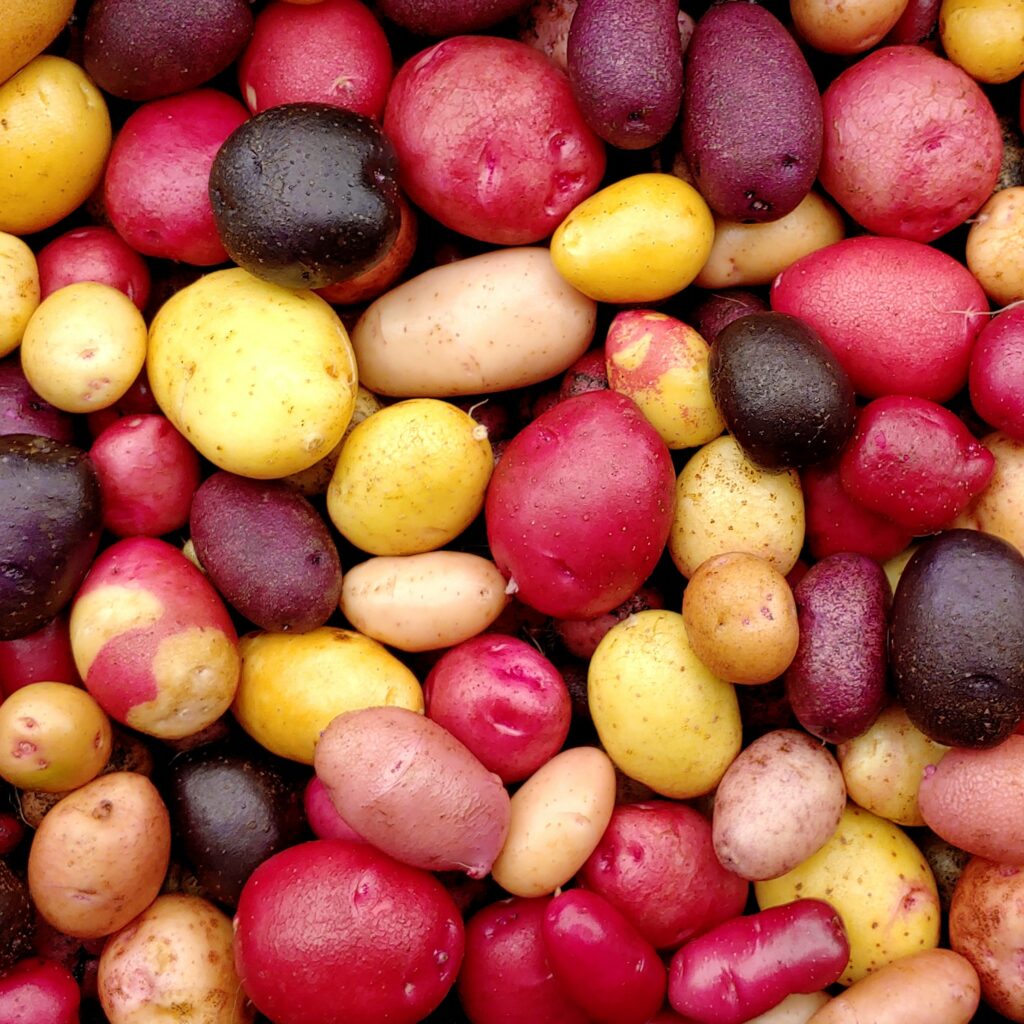Blog, potato (Solanum tuberosum)
Landrace Breeding Potatoes and Other Tubers
Recently, I’ve been getting a lot of questions about “landracing” potatoes and some of the other crops that I work with. I take this as a sign that Joseph Lofthouse‘s new book, Landrace Gardening, is selling well. I highly recommend it. If you have any interest in backyard vegetable breeding, click on that link and buy a copy.
In the book, Joseph lists potato among the crops that are hard to develop as landraces. At first, I was surprised by this, but then I reflected on the fact that I was essentially trying to do landrace breeding with potatoes when I first got started and found it challenging. However, it wasn’t hard because that is an intrinsic quality of the potato; it was hard because I was ignorant of many of the complexities involved in breeding potatoes and had poor access to starting materials. More than a decade later, with a firmer grasp on potato biology and a wide selection of seeds, establishing a potato landrace now strikes me as a relatively easy proposition. The first step on this journey is to learn a little bit about true potato seeds.
Back to the Landraces
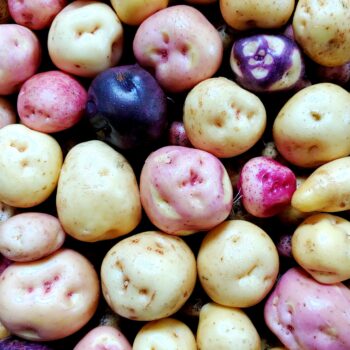
From the domestication of the potato until its introduction to Europe, potato varieties were generally landraces, so we’re not really proposing anything new here. Today, we consider a potato variety to be a single genotype. If you order a hundred pounds of seed potatoes for planting, they are all going to be the same clone, genetically the same out to 99.9999% or so. If you could place an order back in time to an Inca farmer in 1531 and you asked for a hundred pounds of a particular variety, you would probably get something a bit different. You would get potatoes that mostly looked the same, but if you examined their genetic fingerprints, you would probably find several different clones in the mix. Some of them would likely be progeny of some of the others and some might be totally unrelated. These potatoes would have the same general phenotype (the observable traits), but a mix of genotypes (the genes underlying the observable traits). That is a landrace.
How did this come about? Although there is a lot of evidence that the Incas might have had surprisingly sophisticated knowledge of plant breeding, they probably didn’t have a concept of genotype. We have only really had the concept for about 120 years, since the rediscovery of Mendel’s work with peas. If you lack that concept, then it isn’t clear how you might regard two different potatoes with the same characteristics. If you have an oval blue potato with white flesh and blue flowers and your neighbor has one just like it that he got in a long distance trade, are they the same or different? Today, we would suspect that those are really different potatoes, at least in terms of genotype, but the Inca farmers, lacking this concept, would often consider them the same. And, although it can be tempting to think in absolutes, there is really no wrong answer here. Naming landraces was a normal and useful concept and, although understanding genotypes gives us an additional layer of useful information, there is about eight thousand years of potato domestication that suggests we can live without it.
Potatoes, like most clonally propagated plants, accumulate diseases over time, particularly viruses. These pathogens put a burden on the plants that causes the condition of “exhaustion” or “running out,” where the clone ceases to be productive. In an environment where potatoes set true seed easily, as is the case in the native range of the potato in the Andes, volunteer seedlings may grow among the crop planted from tubers. Because these seedlings are descended from the parent crop, they will often have similar characteristics and, because they are largely freed of viruses when grown from true seeds, they may stand out among the crop as more productive plants. The farmer is then likely to select them among the superior seed tubers for planting the next crop. Over time, you have a succession of clonal varieties and their progeny. Andean farmers also exchange seed tubers, often trying to recover types that have stopped performing well for them. The tubers they receive may be similar in phenotype but completely different in genotype. The composition of a landrace changes over time.
Traditional landraces typically had a distinct tuber phenotype, but you are not under any obligation to follow that convention. You could have a landrace of round potatoes that are blue or white, or blue potatoes of any shape, or potatoes with white flesh but any skin color. You could have a landrace of potatoes that taste great but differ in many other traits. You could have a landrace that the Colorado potato beetle doesn’t like to eat, without any regard for the characteristics of the tubers. What you choose to prioritize in your landrace is up to you. In all likelihood, you will select a few things consciously and many more unconsciously. A modern landrace is more often an ongoing project of recurrent selection within a genetically diverse population than the relatively slow evolution of a population, through chance introductions of genetic diversity, that produced traditional landraces.
We don’t grow potatoes as landraces under the modern agricultural system because potatoes are mostly a commodity crop, grown on large acreages and harvested mechanically. The small differences between the different members of a landrace would be enough to cause havoc within this system, where timing of emergence and harvest are crucial to production and profit is figured in a few cents per plant at best. These considerations are not important to the small scale or home grower who harvests by hand. We can do things differently.
Reducing Complexity
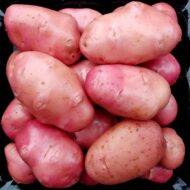
Potatoes are complicated. For a start, they have multiple levels of ploidy, different kinds and amounts of contributions from wild potato species, and reproductive barriers like male sterility and self-incompatibility. Maybe you aren’t clear on what any of that means. If so, that’s OK. You don’t have to understand them to make progress. To avoid dealing with these things, we’re going to introduce a simple rule: to start a potato landrace, we want to start with only self-compatible tetraploid potatoes. These are potatoes that can self pollinate, which means that you can always get true seeds from them. The tricky part here is that most commonly available potatoes are male sterile, so effectively not self compatible.
How do you get started then? I recommend starting with true seed produced by someone else and preferably a mix of varieties. Starting with TPS that have already been selected for self-fertility and good performance will easily save you a couple of years, which ought to be worth a few bucks. If you are determined to start from scratch and make your own seed, I also think that is a great choice. You will learn a lot in the process. Some varieties that you can seek out that meet our criteria are: All Blue (which has many synonyms), Atlantic, Bora Valley, Caribe, Chieftain, Desiree, German Butterball, La Ratte, Red Gold, Purple Majesty, and Yukon Gold. You can find more suggestions in this thread in the Kenosha Potato Project Facebook Group. You should be able to find several of these at most major seed potato suppliers. Grow them, collect any berries, save the seed, and you are ready to start your landrace project.
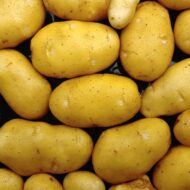
Keep in mind that berries are not an indication that a variety is self fertile and so I don’t recommend trying to start with the berries of unknown varieties. Berries that just happen to be hanging on a neighbor’s plants could give you a false start. Most of the widely available commercial potatoes are male sterile and this sterility is largely permanent. Male sterile potatoes and all of their progeny will require a fertile pollinator in order to set seed. If you start with a mix of fertile and sterile seeds, then you can find yourself backed into a corner in the future. Male sterile potatoes tend to have a slight yield advantage due to an interaction between their cytoplasmic and nuclear genes, so if you diligently select the top performing potatoes for several years, it would not be surprising to find that the majority of them are sterile. You then have a landrace that is hard to maintain, because you will need to keep introducing new, fertile pollinators. As Joseph recommends for many crops with male sterility, it is best to eliminate these at the start so that you can confidently move ahead with selections without having to worry about fertility. Pick your starting materials carefully and you can save yourself a lot of grief.
Establishing Your Landrace
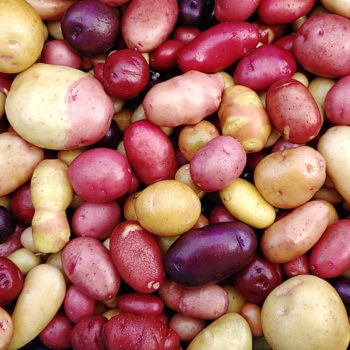
So, you have some true potato seeds, grown yourself, gifted, or bought, and you’re ready to get started. Now what? Let’s think through a few things before you start your seeds. What traits are most important to you? Flavor? Pest resistance? Climate tolerance? Color? Maturity? Dormancy? The relative importance of different traits will vary with your individual preferences and the demands of your environment. It is important to think about this now because some traits are more laborious to evaluate than others, which can put a limit on how much you should plant.
Traits like pest resistance and climate tolerance can usually be evaluated without even digging, but they are also relatively hard to find, so this is a case where you should grow as many plants as possible, choosing to discard most of them before you even dig them up. Color can obviously be evaluated when you dig, also pretty easy. Flavor takes some work. How many potatoes do you have time to taste test and how long will it take? You might need some storage space for all those tubers while you are working through them. If dormancy is a key trait for you, as it might be if you live in a place with really long winters, like Alaska, then you need to store all of the possible candidates long enough to evaluate them. If you don’t have a lot of storage space, then you probably don’t want to grow hundreds of plants.
Now is also the time to think about whether you would like to manage your potato landrace as an annual or biennial. In an annual landrace, you sow new plants from true seed every year and you collect the berries to sow the following crop. In a biennial landrace, you grow from true seeds one year and from tubers the next, saving seed every other year.
An annual landrace means never having to save tubers – you can eat them all and only save seed. The challenge is in deciding which plants to save seed from, since the berries will be ready before the tubers. You can choose not to do any selection and just save all the seed, but the quality of your landrace is likely to decline when you don’t select for the best tubers. So the best approach is usually to save the berries from each plant separately and then discard all but the berries that came from the best plants after harvest. This requires space to store the berries and a way to identify the plants so that you know which berries go with which tubers. Another problem with this approach is that many varieties don’t yield well in the first year, so you may discard seed from perfectly good varieties that you would have decided to keep if evaluating in the second year. That said, a variety that is a good performer in the first year is generally a good performer all around.
The easier approach is the biennial landrace. You don’t need to save any true seed the first year. Instead, put your effort into selecting the plants with the best tubers to keep for the next year. You can then plant those selections in greater numbers and save seeds from them. You know that every plant was a high quality selection, so you can just collect all the seeds and bulk them together for the next generation of your landrace. A biennial strategy also makes it easier to start your seedlings because true potato seeds often have dormancy, which makes them a bit more difficult to germinate when they are less than a year old.
These two strategies are simplifications and most people will use both to some extent. For example, there is no reason to stop growing your best selections after the second year. You can grow some of the second year seed alongside third year tubers, introducing new selections and dropping old ones as they decline or don’t measure up to your newer selections.
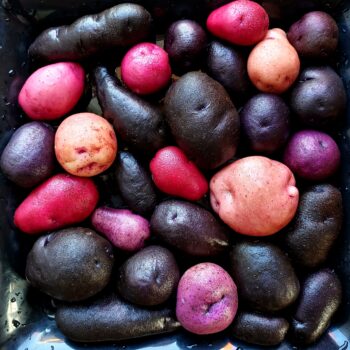
Evaluating your plants is easy. If they produce good yields of healthy, attractive, tasty tubers, then you should probably keep them. If you want it to be that simple, it can be. However, if you want to prioritize certain traits, you will have to do a little more work.
One of the most common preferences is color. Often, people want to have a “rainbow” landrace, including all the colors of potato skin and flesh. Unfortunately, this runs against the genetics underlying color and would require a lot of effort to maintain. Over time, blue and white will tend to overwhelm red and yellow and, in general, if you prefer a particular color, you should remove potatoes of any other color from the pool. If you want landraces of different colors, then you just need to separate them by enough distance so that the majority of the pollen comes from members of the same landrace. Twenty feet would be enough for small plots, but more distance will reduce cross pollination further. This is a landrace, so we don’t need to try for strict isolation. Maturity can also be a bit tricky. Early varieties flower only briefly and they will be overwhelmed by pollen from much more abundantly flowering intermediate and late varieties. So, if you are trying to develop an early landrace, you should be careful about including too many plants with later maturities in your developing landrace.
It is hard to screw up a landrace. If it isn’t going the direction that you want, just introduce some new material that has the traits that you are looking for and resume selecting for what you like best. So, don’t sweat the details too much. For most people who have limited space and time for plant breeding, landraces are an efficient and practical approach to getting some local adaptation while putting your own twist on your favorite vegetables.
While this post has focused on potatoes, the same concept applies to most tuber crops. They are mostly polyploid and clonally propagated, so they have the same kinds of challenges. You can adopt this technique for sweet potatoes, oca, mashua, Jerusalem artichoke, achira, dahlia, and many other tuber crops, although many of them present a greater challenge in producing true seeds.
If you missed the links above, go here to get Joseph’s book, Landrace Gardening: http://lofthouse.com/
Here is my growing guide for true potato seeds: https://www.cultivariable.com/instructions/potatoes/how-to-grow-true-potato-seeds-tps/
Here you can find self-compatible, tetraploid true potato seeds: https://www.cultivariable.com/product-tag/self-fertile-tps/

